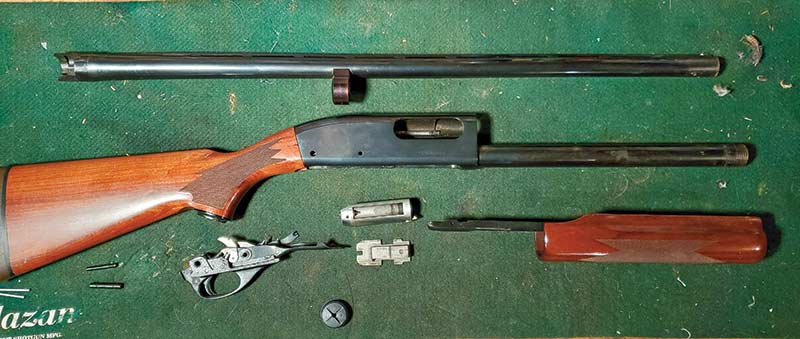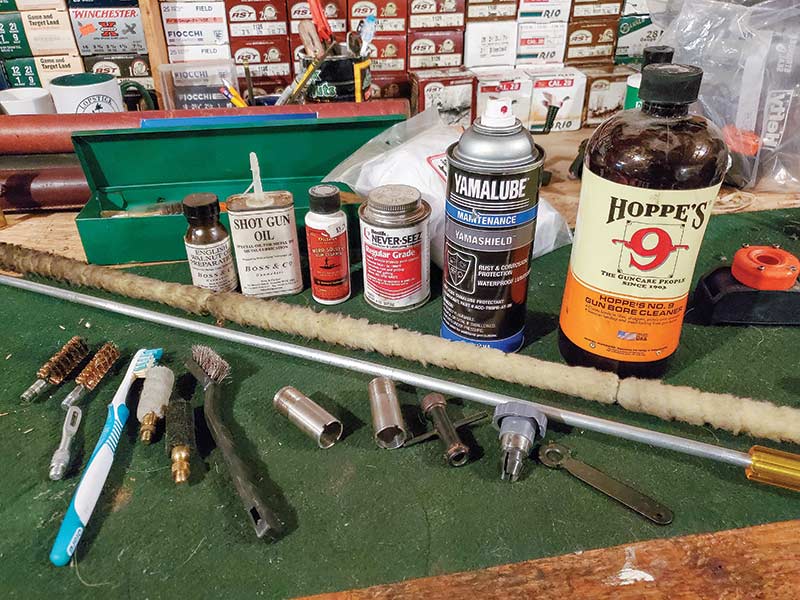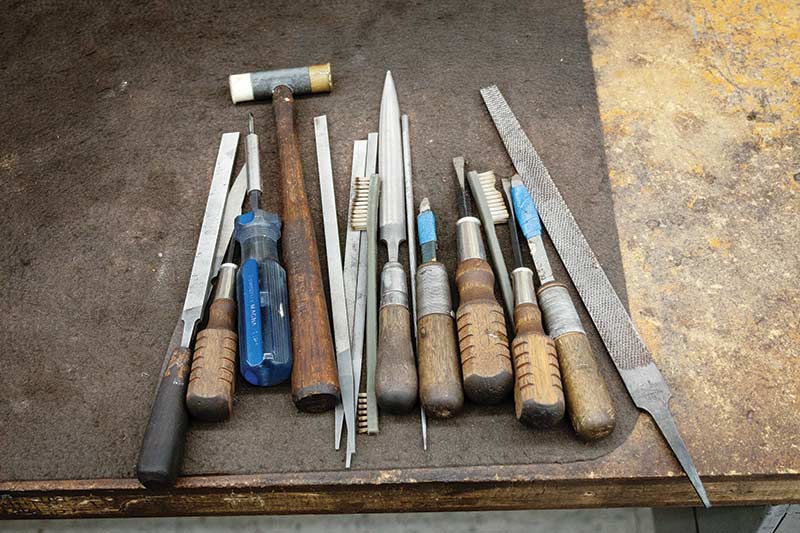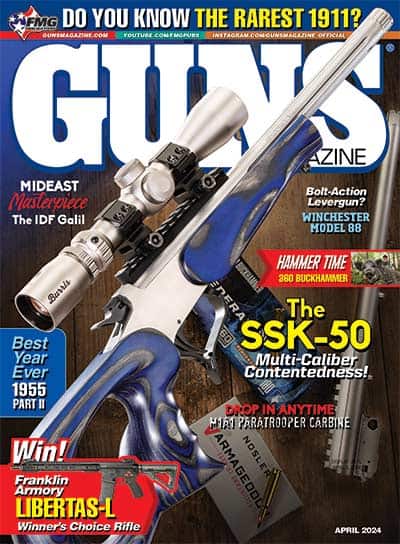Before The Leaves Fall Again
“A Clean Gun is a Happy Gun!”
Is shotgun cleaning more fun than hunting or shooting clays? Not for me, but a clean gun is a happy gun. I clean, oil and repair on a regular basis. Hunting seasons have mostly ended, and now is a great time to handle all cleaning and repairs. It won’t be long before the leaves fall again and when they do, we’ll be ready to roll.
Immediate Cleaning
Water and metal is a terrible combination, especially if you’re sea-ducking along the coast. Before casing a shotgun, wipe down barrels, receivers and stocks with a silicone protectant and lubricant. Keep a cloth and aerosol can of T-9 Boeshield or Yamalube’s Yamashield in your kit. This one wipe-down can save you from finding rust on your barrels when you uncase your shotgun back at camp. Upland guns get wet in a downpour so if the inside of your gun case gets wet, make sure you dry it out before next use.
Tip: Avoid sprays like WD-40. They attract powder residue and turn it into a thick, greasy paste.
Regular cleaning is best done after a few hundred rounds of shooting. If you’re on a low-volume grouse hunt and shoot only a dozen or two shells in an outing, then it’s probably enough to run a wool or fleece cleaning rod through the bores. The thick nap removes powder and carbon fowling as well as any moisture. Spray the shotgun’s exterior with an aerosol silicone and wipe clean after every outing.
If you’ve got into some hot gunning action or are shooting clays, then thoroughly clean your shotgun after each use. Tools specifically designed for our shotguns makes for easy cleaning. A collection of pointed probes are great to access hard-to-reach spots while lint-free rags keep from gunking up moving parts.
Hollow-ground screwdrivers keep from buggering heads. While a standard screwdriver starts tapering immediately from the blade tip, a hollow ground blade is the same thickness at the working end before it starts to taper. Brownells Magna-Tip is ideal. Rachet screwdrivers are ideal for stubborn screws. They keep from marring slots or breaking off heads.
Pin punches remove bolts or pins from receivers, triggers or hammers and there are a variety of them. Straight-end pins are most commonly found in shotguns and they’re easily removed with a simple tap.
Chambers and barrels always are a main focus. Solvents like Hoppe’s 9 break up the residue and clean cotton patches remove it. Brass bristles dipped in solvent are excellent for scrubbing hardened residue. To make life easy, soak a patch in solvent, wrap it around the bristle brush, and run it through the barrel. Repeat until mirror clean, always running from breech to muzzle.
Tip: Stubborn spots might need a bit more torque than your hand can supply. Chuck a metal cleaning rod in a power drill. Add a bristle brush to the working end and use on a light speed.
Choke Up
Choke tubes should be removed and cleaned with solvent. If they’re getting difficult to remove then soak the choke tube in Break Free CLP. The penetrating solution breaks loose corrosion, dirt and build-up on metal. It’s especially good on rusted threads. Clean and lubricate the threads in both the barrel and on the choke tube.
Tip: To keep choke tubes from seizing, lightly coat the tube threads with an anti-seize lubricant like Never Seeze. After reinstalling the choke tube, run a patch through the barrel to remove any excess lubricant.
When it comes to lubrication, less is more. Using too much oil can attract residues. If you’ll be shooting clays soon after hunting season ends, then a light, general oil works best. If you won’t use your shotgun until next season, use a fast-drying anti-rust spray. Be careful with all-in-one products. CLP is fine on choke tubes but it’s not especially good on wood.
Check your manuals for directions on how to remove the barrel, the fore end, the bolt and the trigger assemblies in your favorite pump or semi-automatic. Clean metal parts with mineral spirits, scrub with brushes, and oil lightly. Run a bore brush and patch through the magazine tube to clean and finish with a lightly lubed patch.
For semi-autos you’ll need to scrub the gas assembly and piston. If the ports are really clogged you can use a small drill bit to remove the debris. Comprehensive cleanings for over/unders and side-bys require additional skills making them best handled by a gunsmith.
Go Big
While you’re under the hood, it might be a good idea to tackle some of those bigger projects. Steve Lester and Mike Nelson of Turnbull Restoration Company evaluate many shotguns for repair or full restoration. “It’s never a fail to bring your shotgun to a gunsmith if things don’t go as expected,” Lester said. “We commonly see old side-bys that are loose. If you break open your shotgun and wiggle your wrist, there should be no play between your barrels and your receiver. If there is then you probably need a new hinge pin. Barrel dings are also common and should be corrected. Tight actions are also a common issue; close the action and look for any daylight or space between the barrels and breech face. There shouldn’t be any light shining through. Another issue we see are actively rusting barrels, an issue that should be addressed immediately.”
Mike Nelson differentiates between a repair and a restoration. “Take the long view into account,” Nelson said. “Before you store your shotgun for the season make sure it’s mechanically cleaned, functioning properly and appropriately oiled. But this is a good time to think about a restoration. A partial restoration might be to replace a worn top-lever spring or a safety that constantly sticks. Some folks want buggered screws replaced and dings removed from barrels. Many customers take the next step and return their favorite shotgun to showroom-new condition. In those situations we’ll recase color receivers, re-blue or re-brown barrels, recut smooth checkering and refinish a stock. If you’re frequently buying or selling shotguns then you’d probably want to focus on the repairs. But if you’ve got a favorite shotgun or a family heirloom then maybe a full restoration makes sense.”
Cleaning a shotgun isn’t as fun as shooting a limit of mallards but now the season is over, it’s a good time to clean, repair, or restore your favorite firearm. You’ll be glad you did when it’s working and looking perfect, especially when next year’s leaves start to fall.






